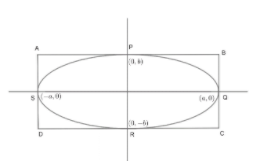Question
Question: A parallelogram circumscribes the ellipse and two of its opposite angular points lie on the straight...
A parallelogram circumscribes the ellipse and two of its opposite angular points lie on the straight lines x2=h2 ; prove that the locus of the other two is the conic
a2x2+b2y2(1−h2a2)=1.
Solution
Hint: Find vertices of parallelogram by intersection of tangents (sides of parallelogram) using parametric coordinates of point of contacts.
We have ellipse given;
a2x2+b2y2=1................(i)
As, given in question, two of the angular points of parallelogram is lying on x2=h2.

ABCDis a parallelogram.
Let AB,BC,CD,DA is touching ellipse at points P,Q,R,S respectively. In other language, we can say that two tangents are drawn from points P and S, two tangents are from P and Q, two from Q and R; similarly, two tangents from R and S, which are intersecting at A,B,C&D respectively.
Let two points which are lying on x2=h2are Band D.
Let point P and Q is (acosα,bsinα) and (acosβ,bsinβ) as parametric coordinates on ellipse a2x2+b2y2=1.
We know that tangent from any point (x1,y1) on ellipse is;
T=0
Or a2xx1+b2yy1=1
Hence, tangents through P(acosα,bsinα) and Q(acosβ,bsinβ);
axcosα+bysinα=1(PB).............(ii)
axcosβ+bysinβ=1(BQ).............(iii)
Let us find intersecting point of equation (ii) and (iii);
By cross multiplication method from equation (ii) and (iii);
bsinα−bsinβx=acosα−acosβ−y=acosαbsinβ−absinαcosβ−1(sinα−sinβ)bx=cosα−cosβ−ay=cosαsinβ−sinαcosβ−ab
Simplifying the above relation to get x and y
x=sinαcosβ−cosαsinβa(sinα−sinβ),y=sinαcosβ−cosαsinβ−b(cosα−cosβ)
We have;
sinC−sinD=2sin2C−Dcos2C+DcosC−cosD=−2sin2C−Dsin2C+DsinCcosD−cosCsinD=sin(C−D)
Therefore, we can rewrite x and yas;
x=sin(α−β)2asin(2α−β)cos(2α+β),y=−sin(α−β)2bsin2α−βsin2α+β
We have;
